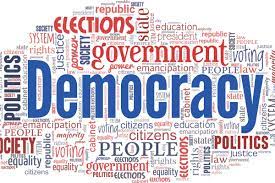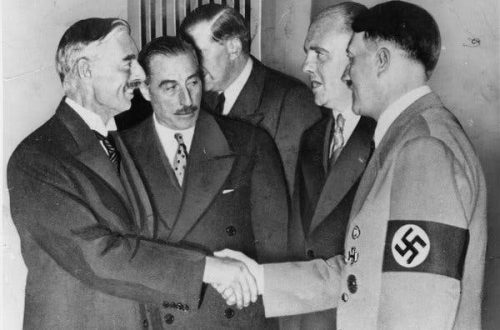Dr. Mohammad Mosaddeq was a popular Iranian politician. An Iranian nationalist, who hailed from a wealthy and prominent family he served as Prime Minister of Iran from 1951 – 1953.[1] According to one of his own cousins, as well as being “Distinguished,” he was “highly emotional.” He would gesture “wildly” in “theatrical” speeches. When he was nervous or in a rage, tears “sprung unbidden from his eyes” that he would wipe away with his hand.[2] His major political achievement was to nationalise the British controlled Anglo-Iranian Oil Company[3] (abrogating an agreement that would have expired in 1993).[4] Mosaddeq’s time as Prime Minister ended abruptly in August 1953 after a CIA sponsored coup that replaced him with a retired army major general, Fazlollah Zahedi.[5]
Myth 1: Mosaddeq was a Democrat.
In an otherwise interesting article about Iran, Danny Postel, writing in The Liberal, comments that “Mohammad Mosaddeq, was nothing if not a liberal democrat!”[6]
The Truth.
Mosaddeq was a constitutional democrat. He accepted the shah reigning but was opposed to him ruling.[7] In his memoirs he claimed that apart from nationalising the oil, his goal was “freedom and independence” for Iran.[8] His political biographer, Homa Katouzian, argues that “Democratic government” was his “most important objective.”[9] Despite this, Mosaddeq did not act as a democrat, at least, not in the way we understand a democrat should act. Kenneth Pollack explains how he gerrymandered an election in 1952 and arranged for the election to be halted when votes came in suggesting that his coalition, the National Front, was not going to win.[10] Moreover, in a national referendum that Mosaddeq called in July 1953:
There were separate ballot boxes for “yes” and “no” votes, and they were generally set up on opposite sides of a room so that a person’s vote was hardly secret. There were other charges of even more deliberate tampering. Not surprisingly, on August 3, Mosaddeq “won” the referendum with more than 99% of the vote.[11]
Pollack also argues that Mosaddeq “had effectively made himself dictator of Iran.”[12]This dictatorial view is shared by Patrick Clawson and Michael Rubin who add that Mosaddeq “increasingly showed himself unwilling to compromise or to tolerate parliamentary dissent”[13] and “increasingly relied on the [Communist] Tudeh and its street thugs to intimidate opponents and constrain any opposition.”[14]
Myth 2: The Coup Against Mosaddeq was all about oil.
I have had many discussions with people of Iranian origin who seem entirely convinced that the CIA led a coup against Mosaddeq for control of Iranian oil.
The Truth.
Mosaddeq was determined to nationalise the British controlled Anglo-Iranian Oil Company. He felt that the 1933 oil concession provided by Iran to the company was invalid and illegal. As such, he actually wanted compensation from the British, arising from what he believed were past wrongs, as opposed to what the British wanted: compensation from Iran for nationalising the company.[15] The British view was that the oil in Iran was “clearly the property of the Anglo-Iranian Oil Company.”[16] This can be compared to Mosaddeq’s view: “The oil resources of Iran, like its soil, its rivers and mountains, are the property of the people of Iran.”[17] These respective positions could not be reconciled.
While the British were unquestionably outraged with Mosaddeq as a result of the oil dispute and wanted him replaced (in fact they had been actively planning to bring him down from at least the summer of 1951)[18] this does not mean the reason that the CIA led the coup against Mosaddeq was for oil interests. The actions of the CIA can mainly be explained by the American fear of communist control of Iran. This fear was in line with that of “Monty” Wodehouse, head of the British MI6 in Iran: “The longer he [Mosaddeq] held office the more probable it became that Iran would pass under Soviet Control.”[19]
Henry Grady, the American Ambassador to Iran, informed Iranian newspapers in 1951 that because of the oil dispute with Britain, there were possibilities either of a British-Iranian war or a Communist takeover of Iran. Grady’s replacement was Loy Henderson who viewed Mosaddeq as “a madman who would ally himself with the Russians.”[20] In August, 1952, The New York Times reported that strategists in both London and Washington had grave concerns of a possible Communist takeover of Iran.[21] On 4 March, 1953, CIA Director Allen Dulles presented a paper to the National Security Council which focused on the “consequences of a Soviet takeover” of Iran. It was felt that if Iran fell to the Communists, the rest of the Middle East might, too. It was this message of fear of Communist control of Iran that was relayed to President Eisenhower.[22] On 28 July, 1953 U.S. Secretary of State John Foster Dulles made a statement to a press conference:
The growing activities of the illegal Communist Party in Iran and the toleration of them by the Iranian Government has caused our government concern.[23]
This was a reasonable assertion on Dulles’ part as there had been frequent statements by Mosaddeq’s National Front suggesting that they were indifferent to a seizure of power by the Tudeh party.[24]
According to Mark Gasiorowski, leading scholar of the 1953 coup, “Almost all U.S. officials working on Iran at the time shared the view that a Tudeh takeover was not imminent but might occur if conditions did not improve.”[25]
As regards whether the coup was for U.S. oil interests:
U.S. policymakers were motivated mainly by fears of a communist takeover in Iran…. The Cold War was at its height in the early 1950s, and the Soviet Union was viewed as an expansionist power seeking world domination. Eisenhower had made the Soviet threat a key issue in the 1952 elections, accusing the Democrats of being soft on communism and of having “lost China”…. [T]he decision to overthrow Mosaddeq appears merely as one more step in the global effort of the Eisenhower administration to block Soviet expansionism.
Moreover, the major U.S. oil companies were not interested in Iran at this time. A glut existed in the world oil market. The U.S. majors had increased their production in Saudi Arabia and Kuwait in 1951 … operating in Iran would force them to cut back production in these countries which would create tensions with Saudi and Kuwaiti leaders.[26]
Myth 3: It was a popular uprising that led to the fall of Mosaddeq.
In an advertisement placed in The New York Times in 2000, Ardeshir Zahedi, the son of the general who had replaced Mosaddeq, argued:
What is certain is that Musaddeq’s fall was not due to any dirty tricks that the CIA might have played….. Musaddeq was overthrown on 19 August when hundreds of thousands of Tehranis poured into the streets to demand his departure and the return of the Shah.[27]
Fariborz Mokhtari presented a similar view in an essay he wrote in 2008 for the Middle East Journal:
The uprising of August 19, 1953, therefore, may indeed have been a popular reaction to the failed coup, contrary to the often unquestioned assertion to the contrary.[28]
The Truth.
The CIA actions in Iran in the summer of 1953 was known as operation TPAJAX. The official CIA internal report on TPAJAX was written in 1954 by Dr. Donald Wilber and was finally made available for use by researchers in 2000 after it was leaked to The New York Times and published in redacted form on their website. As this report was for internal use by the CIA, there is no reason to believe that this was not an accurate portrayal of events. It is totally clear from this report that the CIA had used its contacts and influence to convince the shah to sign “two firmans (royal decrees), one dismissing Mosaddeq and one naming Zahedi as Prime Minister.”[29] What is also clear when reading the report in full is that CIA stage managed all the events surrounding the removal of Mosaddeq.
The CIA, under codename TPBEDAMN with an annual budget of between $500,000 to $1 million, had, from the end of 1940s, hired mob organisers in Iran to attack Tudeh rallies. In advance of the coup being carried out, a budget was provided for a destabilization campaign to “create, extend, and enhance public hostility and distrust and fear of Mosaddeq and his government.” Money was provided to Islamic leaders to make speeches in favour of the Shah and against Mosaddeq, for others to threaten pro-Mosaddeq officials, for rumours to be spread and rallies to be held demonstrating against Mosaddeq and even to Zahedi in order that he could “influence key people.” The plan involved utilising money to create splits in the National Front coalition and have other National Front leaders turn against Mosaddeq. The CIA even had the authority to “purchase” members of the Iranian parliament. The army was encouraged to support the shah and the CIA financed fake Tudeh mobs to created havoc in Tehran. These fake mobs were joined by real Tudeh members who were oblivious to the CIA sponsored action. On 19 August, 1953, the CIA organised anti-Mosaddeq and pro-shah demonstrations and used their contacts to try and persuade the army to join the demonstration and ensure that Radio Tehran was seized. By the afternoon on that day, Mosaddeq was overthrown.[30]
In March 2000 U.S. Secretary of State Madeleine Albright publicly acknowledged that “In 1953 the United States played a significant role in orchestrating the overthrow of Iran’s popular prime minister, Mohammad Mosaddeq.”[31] In his June 2009 speech in Cairo, President Obama said, “In the middle of the Cold War, the United States played a role in the overthrow of a democratically-elected Iranian government.”[32] The most powerful figures in government in any country do not tend to admit to something for which they were not responsible.
Myth 4: The consequences of the coup were the Iranian revolution in 1979 and the terrorist attacks in New York in September 2001.:
In an astonishing conclusion in his bestselling book on the coup, Stephen Kinzer proclaims:
It is not far-fetched to draw a line from Operation Ajax through the Shah’s repressive regime and the Islamic revolution to the fireballs that engulfed the World Trade Center in New York.[33]
The Truth.
The fact that the revolution in Iran occurred in 1979, more than 25 years after the CIA sponsored coup, means that it is an incredible leap to pin the blame of the latter event on the former. It is certainly true that the shah’s regime became repressive but it does not follow that the shah’s measures were a direct and necessary consequence of the CIA actions in 1953. Moreover, had the coup not occurred one cannot rule out the possibility of repression under a different leader. In any event, the violation of human rights in Iran under the Shah was criticised by American officials.[34]
What is clear is that the taking of the American hostages at the U.S. Embassy in 1979-1980 was viewed by some of the hostage takers as a response to the 1953 coup. In the words of one student leader, they wanted to “teach the American government and the CIA a lesson, so it will keep its hands off other countries, and particularly Iran.”[35] But it can also be noted that what inspired the attack on the embassy was an earlier comment by the Ayatollah Khomeini: “It is incumbent upon students in secondary schools and universities and the theology schools to expand their attacks against America and Israel.” A statement made because Khomeini wanted the Americans to return the shah to Iran who had been admitted to America for medical treatment after he had fled Iran following the revolution.[36]
Another reason, unrelated to the US that Khomeini supported the hostage taking was internal politics among the revolutionaries. In a power struggle with more moderate and democratic forces Khomeini saw an opportunity to consolidate his power and get rid of the more liberal government.[37] The taking of the hostages alienated the US and most of the watching world. Those advocating better relations with the world such as the first President of the Islamic Republic Abolhassan Bani sadr, found themselves isolated after the act. The more radical forces were thus able to take control and consolidate their grip on Iran. Barry Rubin notes “the importance of anti-Americanism was not inevitable.” He argues “If, for example, moderates and democrats had seized power in 1979 instead of Khomeini, they probably would have sought good relations with the United States.”[38]
In relation to the claim that the coup against Mosaddeq ultimately led to the attacks in the US on 11 September, 2001, it is possibly lost on Stephen Kinzer that the Iranians are Shiite and the al-Qaeda terrorists who carried out the attacks were Sunnis who detest the Shiites. In any event, as Efraim Karsh comments:
[The 11 September, 2001] attacks, and for that matter Arab and Muslim anti-Americanism, have little to do with US international behaviour or its Middle Eastern policy. If, today, America is reviled in the Muslim world, it is not because of its specific policies but because, as the preeminent world power, it blocks the final realization of this same age-old dream of regaining the lost glory of the caliphate. As such, it is a natural target for aggression. Osama bin Laden and other Islamists’ war is not against America per se, but is rather a manifestation of the millenarian jihad for a universal Islamic empire (or umma).[39]
Acknowledgements
The author would like to thank Barry Rubin for reading the final version and David Patrikarakos for his numerous comments on earlier drafts and for editing this article.
References
Clawson, Patrick and Michael Rubin 2005, Eternal Iran: Continuity and Chaos, New York: Palgrave Macmillan.
Daniel, Clifton 1952, “U.S. and Britain Confronted By Dilemma on Help to Iran,” The New York Times, 11 August: 3.
Efimenco, N. Marbury 1955, “An Experiment with Civilian Dictatorship in Iran; The Case of Mohammed Mossadegh,” The Journal of Politics, Vol. 17, Number 3, August: 390-406.
Gasiorowski, Mark J. 1987, “The 1953 Coup D’etat in Iran,” International Journal of Middle East Studies, Vol. 19, Number 3, August: 261-86.
Gasiorowski, Mark J. 2004, “The 1953 Coup d’État Against Mosaddeq,” in Mohammad Mosaddeq and the 1953 Coup in Iran, edited by Mark J. Gasiorowski and Malcom Byrne, New York: Syracuse University Press: 227-60.
Karsh, Efraim 2007, Islamic Imperialism: A History, New Haven and London: Yale University Press.
Katouzian, Homa 1999, Musaddiq and the Struggle for Power in Iran, (Revised Second Edition), London and New York: I.B. Tauris & Co. Ltd.
Keddie, Nikki R. 2003, Modern Iran: Roots and Results of Revolution, New Haven and London: Yale University Press.
Kinzer, Stephen 2008, All the Shah’s Men: An American Coup and the Roots of Middle East Terror, Hoboken, New Jersey: John Wiley & Sons, Inc.
Kirkpatrick, Jeane 1979, “Dictatorships and Double Standards,” Commentary Vol. 68, Number 5, November: 34-45.
Louis, Wm. Roger 2004, “Britain and the Overthrow of the Mosaddeq Government,” in Mohammad Mosaddeq and the 1953 Coup in Iran, edited by Mark J. Gasiorowski and Malcom Byrne, New York: Syracuse University Press: 126-77.
Mokhtari, Fariborz 2008, “Iran’s 1953 Coup Revisited: Internal Dynamics versus External Intrigue,” Middle East Journal, Vol. 62, Number 3, Summer: 457-88.
Pollack, Kenneth M. 2005, The Persian Puzzle: The Conflict Between Iran and America, New York: Random House.
Postel, Danny 2008, “Iran and the Future of Liberalism,” The Liberal, Issue 12, Summer, online at http://www.theliberal.co.uk/issue_12/politics/iran_postel.3_12.html, (Accessed 16 January, 2010.)
Rubin, Barry 2003, “Lessons From Iran,” The Washington Quarterly, Vol. 26, Number 3, Summer: 105-15.
Sanger, David E. 2000, “U.S. Ending a Few of the Sanctions Imposed on Iran,” The New York Times, 18 March: A1, A5.
“Text: Obama’s Speech in Cairo,” 2009, The New York Times, June 4, online at http://www.nytimes.com/2009/06/04/us/politics/04obama.text.html?pagewanted=1&_r=1 (Accessed 29 January, 2010.)
Weiner, Tim 2007, Legacy of Ashes: The History of the CIA, New York: Doubleday.
Wilber, Donald N. 1954, Overthrow of Premier Mosaddeq of Iran: November 1952-August 1953 Central Intelligence Agency, March. Available on line via the following link: http://www.gwu.edu/~nsarchiv/NSAEBB/NSAEBB28/, (Accessed 16 January, 2010.) NB, the website cryptome.org has managed to recover much of the redacted text and has published a restored version of the report on line at http://cryptome.org/cia-iran-all.htm. (Accessed 16 January 2010.)
Zahedi, Ardeshir 2000, “The CIA and Iran: What Really Happened,” The New York Times, 22 May: A17 (Display advertisement.)
Notes
[1] Katouzian 1999, pp.ix-x
[2] Kinzer 2008, p. 58.
[3] Gasiorowski 1987, p. 262.
[4] Keddie 2003, p. 101.
[5] Gasiorowski 1987, pp. 273-5.
[6] Postel 2008.
[7] Pollack 2005, p. 62.
[8] Katouzian 1999, p. x.
[9] Katouzian 1999, p. x.
[10] Pollack 2005, p. 61.
[11] Pollack 2005, p. 66.
[12] Pollack 2005, p.62.
[13] Clawson and Rubin 2005, p.64.
[14] Clawson and Rubin 2005, p.65.
[15] Louis 2004, p. 150.
[16] Kinzer 2008, p. 121.
[17] Kinzer 2008, p. 124.
[18] Katouzian 1999, p. 137, p. 177.
[19] Louis 2004, p. 161.
[20] Kinzer 2008, p.117.
[21] Daniel 1952.
[22] Weiner 2007, pp.84-5.
[23] Wilber 1954, p.29n.
[24] Efimenco 1955, p.405.
[25] Gasiorowski 2004, p.231.
[26] Gasiorowski 1987, p.275.
[27] Zahedi 2000.
[28] Mokhtari 2008, p.484.
[29] Wilber 1954, pp. 36-38.
[30] Gasiorowski 2004, pp. 236-256.
[31] Sanger 2000.
[32] “Text: Obama’s Speech in Cairo,” 2009.
[33]Kinzer 2008., pp. 203-204. It appears that Kinzer viewed Mosaddeq as someone deservedof worshipping. On page 221 he describes how, on a trip to Iran, he saw the gates to the house that Mosaddeq had lived in. He claimed that these gates had “an almost spiritual aura” and that he placed his hand on the gate “and held it there for a long time.”
[34] Kirkpatrick 1979, p. 35.
[35] Pollack 2005, p.154.
[36] Pollack 2005, p.154.
[37] Keddie 2003, p. 248.
[38] Rubin 2003, p.111.
[39] Karsh 2007, p. 239.


